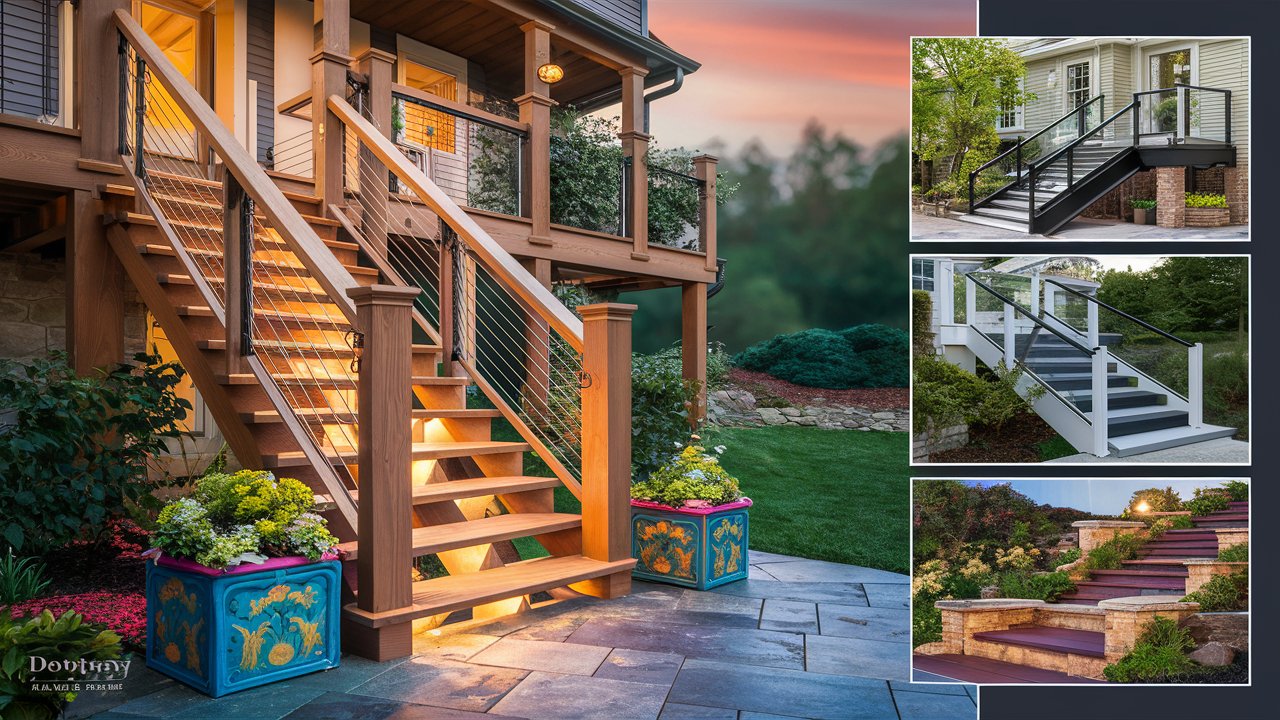Introduction
Creating a beautiful and functional mountain landscape requires thoughtful planning and the use of natural elements that complement the surroundings. Whether you’re designing a landscape for a mountain home or looking for big rock landscaping ideas, incorporating features like water elements, fire pits, and native plants can create a cohesive and inviting outdoor space. Mountain landscapes thrive on natural materials like stone and wood, which not only enhance the visual appeal but also provide durability and low maintenance, perfect for those who want to enjoy their surroundings without constant upkeep.
By combining walkways, retaining walls, and focal points like fire pits, you can create a landscape that feels both organic and structured. Low-maintenance options such as drought-tolerant plants and hardscaping ensure that your mountain landscape remains beautiful throughout the year, with minimal care required. From pathways lined with native plants to large boulders that provide visual interest, there are endless possibilities for creating a relaxing and natural environment in a mountain setting.
Key Takeaways
- Incorporating natural elements like stone, wood, and water features enhances the beauty and functionality of mountain landscapes.
- Big rock landscaping provides a rugged, natural look that blends seamlessly with the surrounding environment.
- Walkways and pathways made from natural materials offer both aesthetic appeal and practical use in a mountain setting.
- Low-maintenance landscaping with drought-tolerant plants ensures your mountain landscape remains beautiful with minimal effort.
- Fire pits and retaining walls add focal points and structure to your outdoor space, promoting relaxation and comfort.
- Using native plants and hardscaping elements allows for a cohesive design that reflects the natural beauty of the mountain environment.
Inspiring Landscape Ideas for Your Mountain Home

Mountain homes offer the perfect canvas to integrate natural elements into your landscape ideas. Whether it’s the use of native plants or the addition of rustic outdoor structures, you can create a space that feels both inviting and naturally connected to the surrounding environment. Incorporating a water feature, such as a waterfall or pond, brings movement and a calming atmosphere to the landscape. Fire pits are another great addition, providing warmth and relaxation for evening gatherings. Mountain landscape design thrives on the use of materials like stone, wood, and natural plants, allowing the outdoor space to reflect the raw beauty of its setting. The right landscape design will not only enhance the visual appeal of your mountain home but also provide a space that encourages relaxation and connection to nature.
Using Water Features to Enhance Mountain Landscaping
Water features, such as waterfalls, ponds, or even small streams, can transform your mountain landscape into a serene retreat. Incorporating a waterfall or a flowing water feature into the design not only adds visual interest but also provides a calming sound that enhances relaxation in your outdoor space. Using natural materials like stone or wood for the edges of these water features will help them blend seamlessly into the natural surroundings. Whether it’s a large pond surrounded by native plants or a small waterfall tucked among boulders, water features are an excellent way to highlight the beauty of your landscape and create a soothing atmosphere.
Fire Pits as a Focal Point in Mountain Homes
A fire pit is more than just a heat source; it can serve as a central gathering spot in your outdoor space, perfect for relaxing evenings with family or guests. In mountain landscapes, fire pits made of natural stone or other rustic materials provide a visual focal point that enhances the aesthetic of the landscape. Surround the fire pit with comfortable seating and use plants to soften the hardscape. Adding shrubs or perennials nearby can create texture and color, making the space feel cozy and inviting. Not only does a fire pit provide warmth, but it also creates an ideal spot for enjoying the natural surroundings of your mountain home.
List: Landscape Elements to Boost Relaxation
1. Native Plants and Trees
Incorporating native plants and trees into your mountain landscape can enhance relaxation by creating a natural and calming environment. Choose species that thrive in mountain climates and require minimal upkeep, ensuring that your outdoor space remains serene and low-maintenance.
2. Outdoor Structures for Lounging
Outdoor structures like pergolas or wooden decks can serve as quiet spaces for relaxation. By adding comfortable seating areas near a fire pit or water feature, you can create an outdoor retreat where family and friends can unwind and enjoy the natural beauty of your mountain home.
Big Rock Landscaping: Design Ideas for a Natural Look

Big rock landscaping is an excellent way to create a natural look that blends seamlessly with the surrounding mountain landscape. Boulders and large rocks can be strategically placed to form natural retaining walls, define garden beds, or line a walkway. These elements provide a rugged, earthy feel that complements the rustic charm of mountain homes. Water features such as waterfalls can be built around large rocks, adding sound and movement to your outdoor space. You can also incorporate outdoor structures like stone patios or fire pits made of natural stone to create gathering spaces. Using local materials and native plants will enhance the overall design, creating a natural aesthetic that feels like an extension of the environment. Big rock landscaping offers durability, visual interest, and the timeless appeal of natural elements.
Building Natural Retaining Walls with Boulders
Retaining walls are a functional necessity in many mountain landscapes, and using boulders or large rocks for these walls adds both beauty and stability. Natural stone retaining walls create a seamless transition between different levels of the landscape, helping to manage slopes and prevent soil erosion. Additionally, these boulders blend into the environment, enhancing the natural look of the space. Native plants can be added along the top or bottom of the wall to soften the hard edges and bring life to the area. The combination of rocks, plants, and surrounding landscape makes these retaining walls a visually appealing solution for sloped terrains.
Incorporating Boulders into Garden Beds
Boulders are not only functional but also serve as decorative elements in garden beds, creating natural focal points that draw the eye. By placing large rocks among native plants and trees, you create an appealing contrast between hard and soft textures. These rocks can also be used to define the edges of garden beds or to create pathways that lead visitors through the space. Surrounding boulders with flowering perennials or drought-tolerant shrubs adds bursts of color, while the rocks provide year-round structure to the garden. Big rock landscaping allows you to create a natural, low-maintenance garden that fits perfectly with a mountain setting.
Case Study: Big Rock Landscaping Success
In Utah, a homeowner transformed their mountain home’s outdoor space using big rock landscaping. They incorporated large boulders into the garden to create terraced beds that flowed naturally with the sloped landscape. Native shrubs like rabbit bush and sun-loving perennials were planted around the rocks, reducing water consumption and providing year-round visual interest. By using local stone materials and native plants, the homeowner achieved a natural, cohesive landscape that required minimal upkeep. This approach allowed the garden to seamlessly blend into the surrounding mountain environment, reflecting the homeowner’s desire for a sustainable, low-maintenance outdoor space.
Creating Walkways and Pathways in a Mountain Landscape

Incorporating walkways and pathways in your mountain landscape is not only practical but also essential for enhancing the natural flow of your outdoor space. By using materials like natural stone or wood, you can create pathways that feel like an organic part of the environment. These walkways can guide visitors through garden areas, over streams, or up gentle slopes, offering scenic views along the way. Using plants and trees along the edges of pathways softens hard edges and creates a more inviting look. You can also add focal points like garden sculptures or water features to draw attention to specific areas. A well-planned pathway ensures easy access while maintaining the natural beauty of the landscape. Whether winding through a forested area or skirting a boulder field, these walkways become a functional and aesthetic highlight of your landscape design.
Designing Walkways with Natural Stone
Walkways made of natural stone not only provide a functional route through your mountain landscape but also add an organic beauty that complements the environment. Stone pathways are durable and can withstand the rugged conditions of mountain weather while maintaining their aesthetic appeal. These walkways can lead from the front yard to the backyard or through garden areas, providing visual interest along the way. Using different textures and colors of stone adds variety, while surrounding the pathway with native plants and shrubs creates a soft transition between the hardscape and the landscape. This approach ensures the walkway feels like a natural extension of the land.
Blending Pathways with Native Plants and Trees
To ensure your walkways blend with the natural surroundings, consider lining them with native plants and trees that thrive in mountain environments. By planting shrubs and trees along the edges, you can create a seamless transition from the pathway to the rest of the landscape. This also softens the hard edges of the stone or wood, making the path feel more integrated into the environment. Native plants like huckleberry, rabbit bush, and sun-loving perennials can provide pops of color and texture without requiring excessive maintenance. This design approach not only enhances the beauty of the landscape but also promotes a cohesive, natural look.
“In every walk with nature, one receives far more than he seeks.” – John Muir
Low-Maintenance Landscape Design for Mountain Homes

For homeowners looking to enjoy the beauty of a mountain landscape without constant upkeep, low-maintenance landscape design offers the perfect solution. By incorporating drought-tolerant and native plants, you can create a lush and sustainable garden that thrives with minimal water and care. Perennials, shrubs, and hardy ground covers that are well-suited to mountain climates can provide year-round color and texture. Hardscaping elements like retaining walls, stone patios, and fire pits reduce the need for regular maintenance while adding function and beauty to the space. Natural materials like stone and wood not only blend with the mountain environment but also provide durable, long-lasting design features. With thoughtful planning, you can create an outdoor space that requires less work but still offers a beautiful, relaxing environment year-round, perfectly suited for mountain living.
Choosing Drought-Tolerant Plants for Low Maintenance
Mountain climates can sometimes be harsh, and choosing drought-tolerant plants ensures your landscape remains beautiful with minimal effort. Plants like goldenrod, rabbit bush, and huckleberry are well-suited to these environments, offering vibrant colors and textures that last throughout the seasons. By selecting plants that are native to the region, you reduce the need for excessive watering and upkeep. These low-maintenance plants thrive in the natural conditions of the mountain landscape, allowing you to enjoy a beautiful garden without spending too much time on care. Incorporating these drought-tolerant plants will help maintain a sustainable and eco-friendly landscape.
Incorporating Hardscaping for Durability and Ease
Hardscaping is a key element in low-maintenance landscape design, especially for mountain homes. By incorporating durable materials like stone or wood for pathways, retaining walls, and patios, you can reduce the amount of maintenance required over time. Hardscape elements are not only functional but also add structure and definition to your outdoor space. Fire pits, stone patios, and seating areas made from natural materials help create outdoor living spaces that are both practical and visually appealing. With the right balance of plants and hardscaping, you can achieve a landscape that looks stunning and requires minimal effort to maintain.
Conclusion
Designing a mountain landscape that blends seamlessly with its surroundings while offering both beauty and functionality is achievable with the right approach. By focusing on natural elements like rocks, native plants, and water features, you create a landscape that not only enhances the aesthetics of your mountain home but also promotes a sense of tranquility. Whether it’s big rock landscaping or incorporating pathways that guide visitors through the landscape, every element plays a role in creating a cohesive and natural look.
Low-maintenance design options, such as drought-tolerant plants and hardscaping, make it easier to maintain the landscape throughout the year. Fire pits, retaining walls, and outdoor structures can also provide practical and visual benefits, ensuring your mountain landscape remains inviting and enjoyable. With careful planning and the right materials, your outdoor space can be a reflection of the natural beauty that surrounds it.






